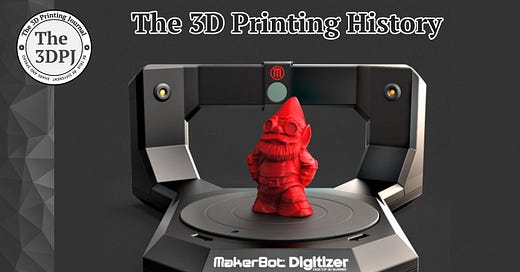08-22-2013: MakerBot officially launched the MakerBot Digitizer desktop 3D scanner
It wasn't perfect, but it allowed many people around the world to enter the world of 3D scanning
On August 22, 2013, MakerBot announced the availability of the MakerBot Digitizer desktop 3D scanner, accepting first pre-orders with shipping expected by mid-October. It was offered at the surprisingly low price (for that time) of $1,400. The 3D scanner was optimized for MakerBot's Replicator Desktop 3D printers and the Thingiverse platform.
The Digitizer 3D scanner was first unveiled in March 2013 as a prototype during SXSW in Austin. It was a true prototype, with a laser-cut plywood casing and dangling side cables. The product presented six months later was a fully professional consumer-grade device, packaged in an elegant black casing, stylistically matching the recently released MakerBot Replicator 2.
MakerBot’s scanner featured simple yet sophisticated software that turned physical objects into 3D digital design files in approximately 12 minutes, saved files in the standard STL format, and allowed easy uploading of scans directly to Thingiverse. The maximum size of scanned objects was up to 8" in diameter and 8" tall (~20 x 20 cm) and up to 6.6 lbs (~3 kg).
Other technical specifications included dimensional accuracy of ± 2.0 mm, detail resolution of 0.5 mm, scan speed of approximately 12 minutes, two eye-safe Class 1 laser line generators, and a camera with a 1.3 megapixel CMOS image sensor.
The Digitizer was a product developed before MakerBot was acquired by Stratasys, so it was a project of the "old team." Nonetheless, in its early years, the 3D scanner enjoyed considerable popularity—due to the strength of the MakerBot brand, its attractive design and relatively affordable price, and the fact that competition at that time was minimal.
However, MakerBot officially discontinued the Digitizer 3D scanner in April 2017. The decision was made as the company shifted its focus more toward its core business of 3D printing and other areas of growth. The discontinuation reflected the growing competition in the 3D scanning market and the need for higher resolution and more advanced scanning technologies, which the Digitizer, being a relatively early consumer-grade scanner, could not fully provide.
Overall, the MakerBot Digitizer played a significant role in popularizing 3D scanning among consumers and small businesses. Although it had many limitations, it served as an introduction to the concept of digitizing physical objects for 3D printing, inspiring further developments in the 3D scanning market.
Source: www.3ders.org





